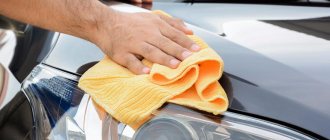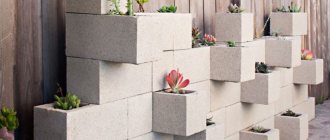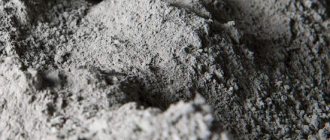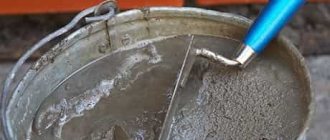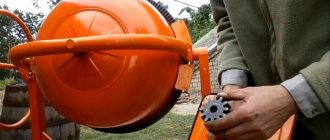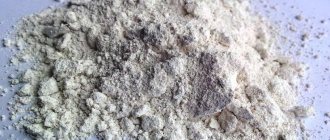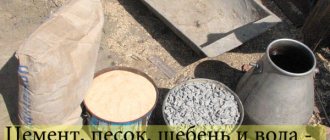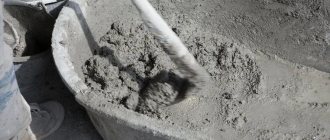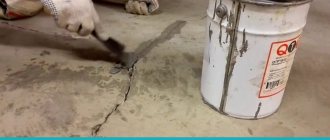During any construction, concrete is used, for the preparation of which a concrete mixer is required. This device is indispensable if the cement composition is not purchased ready-made, but is mixed independently. But after several uses, a layer of mixture sticks to its inner surface, which is difficult to remove. This occurs due to errors in concrete mixing technology, as well as due to lack of mixing. To clean a concrete mixer from dried mixture, mechanical or chemical methods are used.
By mechanical means
Physical impact is considered the most popular and widespread method for cleaning a concrete mixer. In modern construction, the following methods are most often used.
Using crushed stone
When using this method, no mechanical action is required; the concrete mixer cleans itself.
About 3 liters of water are poured into the bowl, and then two buckets of fine crushed stone or gravel are poured.
The device then turns on and begins to rotate.
Using the blades of a concrete mixer, an abrasive mass is mixed, which can break up and clean off the cement layer.
This method allows you to clean the concrete mixer without the use of additional equipment. The whole process lasts about 10 minutes. The proportions of substances are indicated for a medium-sized concrete mixer (120-150 l), which is usually used in domestic conditions. If the container is much larger, you need to increase the amount of crushed stone by adding another bucket (or half a bucket). 0.75 liters of water is poured into each bucket of crushed stone.
The essence of this process is that when mixing, the abrasive mass reaches the very edges of the bowl, then they will not remain dirty. Therefore, you should not save on crushed stone.
After the procedure is completed, the remaining mass is drained. If necessary, the entire process is repeated. Then you can thoroughly rinse the concrete mixer with a hose. After completing the procedure, the device is completely ready for new concrete mixing.
Using a drill or grinder
To use this method, you will have to purchase a special attachment in the form of a metal brush from the store.
This method is considered quite gentle; during its use, only the paint on the inner surface of the unit may be damaged.
But the method also has a significant disadvantage. To completely clean the device from the frozen solution, it will take about 30-60 minutes. In addition, you will have to take breaks. The speed of work also depends on the size of the concrete mixer. According to the principle of use, the method is similar to grinding the material.
Important! It is recommended to wear safety glasses (mask) and gloves during cleaning. During the procedure, small fragments of cement and dust fly in all directions, so ignoring safety precautions can lead to injury.
Chisel and hammer
These tools can be easily found in any home. The method of their use involves the application of physical force, because to clean you will have to knock the composition off the walls of the device. The method is not recommended for use on dried concrete, since the tools can scratch the drum or deform it. Using a chisel with a hammer cannot ensure perfect surface cleaning. It is recommended to use the method only if other methods do not help.
With a shovel
This method can be considered the oldest and simplest; it is most often used in everyday life.
The shovel has a pointed edge; it is convenient for cleaning off the remaining concrete mixture from the inner surface of the bowl.
Fresh composition can be removed well, but with frozen composition you will have to work hard.
Using a shovel to scrape the blades of a device with dried cement is not a good idea. They are very easy to damage, and this can significantly affect the quality of future concrete mixtures. And the walls of the bowl don’t like it when sharp metal is driven across them. Therefore, this method is not recommended for use on dried mixtures.
How to clean hardened cement from a concrete mixer?
Builders know that a concrete mixer is one of the important and indispensable construction tools. During construction work, you cannot do without cement mortar. Of course, you can buy a ready-made solution, but this is not always convenient: the ready-made solution hardens quickly. It is precisely when a certain amount of ready-made cement mortar is needed that it is more convenient to use a concrete mixer, especially since they come in different volumes.
People who are engaged in work related directly to the use of cement mortar know how difficult it can be to clean a concrete mixer from dried mortar and how incompletely removed contaminants affect the operation of the tool. A good builder should have all his tools in perfect order and always ready for work.
Very often, people, having started construction of a cottage, are forced to buy a concrete mixer: they understand perfectly well that if they use it carefully, then after construction is completed, they can always sell the concrete mixer without much loss. In turn, anyone who has just started construction will be very happy to purchase a used concrete mixer in working condition.
By chemical means
To clean a concrete mixer from adhering composition, there are not only physical methods. Methods that involve the use of chemicals are also considered very effective.
Hydrochloric acid
To remove a layer of dried concrete from the walls of a concrete mixer, a 5-10% solution of hydrochloric acid is suitable.
Its quantity depends on the size of the device bowl.
The product must be poured inside the drum, turn it on and wait a few minutes.
It is important that the solution gets onto the edges of the concrete mixer so that the entire bowl is washed. After completing the procedure, the waste liquid should be disposed of and the soda solution should be poured into the drum. It neutralizes the effect of acid residues. Then rinse the drum thoroughly with water.
The main disadvantages of this method are the inaccessibility of the acid and problems with its disposal after washing. You should also pay special attention to hand protection (gloves). If you ignore this rule, you can get a serious skin burn.
Special cleaning solutions
In order to wash the solution from the surface of the concrete mixer drum, there are also special chemicals. Their main advantage is that they can be purchased at any store, and the disposal method is described in detail in the instructions. There is also information about the method of preparing and using the solution. The whole process is quite easy and fast, the use of physical force is not required, and after cleaning the concrete mixer looks like new. The main disadvantage is the high cost of components.
Bio Decap Beton Guard solvent is most often used in construction, but it can also be used before mixing concrete.
The Lugato cleaner helps a lot.
No less common is the “Khimfrez” product, but it can only be used when the air temperature is more than +5 degrees Celsius.
Additional cleaning options
The sand-water mixture is also used for cleaning.
In addition to the well-known methods described above for cleaning the concrete mixer from cement mixture residues on the inside of the drum, additional methods can be used:
- Sand. A sand-water mixture is prepared directly in the drum, with a consistency close to liquid porridge. The amount of solution required is determined based on the size of the drum. The essence of the procedure is simple - water dissolves cement residues, sand cleans them off, acting as a natural abrasive. After preparing the necessary mixture for cleaning, turn on the concrete mixer - just rotate the drum several times. Next, the dirty water is replaced with clean water (the sand should not be touched). The procedure is repeated several times until the internal surface is completely cleaned. To remove sand at the end of the procedure, crushed stone is used. The indisputable advantage of this method is that the cleaning process occurs in a gentle manner, without harming the surface. Of course, you need to spend some time. The advantages include the fact that the sand and crushed stone used during cleaning can be immediately used to prepare a new solution.
- Cleaners. A modern way to clean a concrete mixer is to use chemical cleaning agents. Special components in their composition carefully separate hardened cement, leaving the surface of the drum untouched.
Of course, it is best to clean the drum immediately after completing the work process. Then you don’t need to make any special efforts; the cement can be easily cleaned off with strong water pressure. Residues are cleaned off using crushed stone as described above.
Return to contents
How to prevent sticking when kneading
If you correctly follow the sequence of actions while mixing the mortar, this can protect the concrete mixer from subsequent cement sticking. In addition, there are several tricks that professional craftsmen use while working:
- When mixing the composition, you should first pour clean water into the container, and then add cement and other components. This can partially save the inner surface of the concrete mixer from sticking of the composition.
- Before kneading begins, a small amount of diesel fuel is poured onto the inner walls. The main thing in this matter is not to overdo it, otherwise the diesel fuel will affect the quality of the future concrete and the speed of its hardening.
- Stores sell special substances that prevent concrete from sticking to walls. They have a chemical composition with different concentrations. Some products are completely ready for use; they just need to be sprayed onto the bowl and fan using a spray bottle. Others will have to be diluted with water, and then poured into a concrete mixer and turned on for 10-15 minutes. When using such substances, you should carefully read the instructions and protect your hands from harmful chemical effects.
- Often, builders lubricate concrete mixer blades with oil (or oily compounds) to prevent sticking. In fact, you shouldn't do this. Oil, on the contrary, attracts sand and also accelerates wear of the mechanism due to its abrasive effect.
- The easiest way to prevent sticking is to rinse the drum immediately after mixing the product. Concrete does not have time to set and stick strongly, so it is easy to remove with clean water.
Important! Concrete sticks little to the outer surface of the device, so there is no need to lubricate it with anything. To remove traces of fresh composition, run a hose filled with water over it.
Cleaning a concrete mixer from adhering mortar is a difficult, lengthy and labor-intensive process. To avoid it, it is better to take care of the mechanism in advance and lubricate it from the inside with special products. If sticking does occur, then it is better not to waste time and immediately get rid of the remaining concrete on the walls using water. And if the mixture has managed to harden, then the safest thing to do is to remove traces using chemicals. The use of physical force can have a detrimental effect on the mechanism of the device.
Features of equipment operation
A concrete mixer, that is, a concrete mixer, is a device for preparing a concrete solution from cement by mixing dry components with water in the required ratio. The design includes a drum, a traverse, a frame (frame), a rotation mechanism, a latch, a mechanical and electrical part. A drum is a mixing chamber, that is, a container of a certain volume, inside of which blades are installed for mixing the mixture.
Large frozen pieces of concrete are simply knocked down with a chisel.
Concrete ingredients and cement are loaded manually while the drum rotates. The sequence of loading dry components and pouring water has its own order, and its violation leads to premature setting of the solution and sticking of cement to the walls of the chamber. The container is unloaded by turning the drum down and spontaneously flowing out the solution. After unloading the mass, part of the concrete remains inside and when the drum stops, it quickly hardens and sticks to the metal.
Thus, during operation of the concrete mixer, mass accumulates on the outside as a result of splashing during unloading, and inside the chamber there is adhered and hardened composition due to a violation of the technology, incomplete unloading or prolonged stoppage of rotation. If the equipment is not thoroughly cleaned every day, removing all residues and splashes, the frozen mass accumulates and becomes an obstacle to the operation of the equipment: it clogs the running and adjusting mechanisms on the outside, and on the inside, it weighs down the drum and blocks the blades. Therefore it is necessary to clean the installation both inside and out.
Using water
The hydrotreating method is considered one of the most effective and safe. To clean the concrete mixer from hardened cement, use Karcher high-pressure mini washers or similar ones. The water jet is supplied under pressure from 180 to 280 Bar. The special “mud cutter” attachment included in the kit, designed to remove hard, old deposits, greatly simplifies the process.
Thanks to the rotary design of the nozzle, the rotating jet of water “cuts off” even dense deposits. When using, it is worth considering that intense exposure can cause harm to the surface being treated. To break up cement stone or clean hard-to-reach mechanisms, use a point nozzle.
Types of pollution
To effectively clean cement, it is important to take into account the type of contamination, i.e. its duration. Usually 3 types are considered:
Usually 3 types are considered:
- up to 1 day;
- up to 1 month;
- more than 1 month.
The best way to remove fresh cement marks at home is to remove them. But sometimes it is necessary to clean dried cement. Let's find out how to wash cement from clothes, wash windows after renovation, and clean indoor and outdoor tiles from hardened and persistent cement deposits.
Fresh cement
It is best to remove unwanted contaminants before the concrete hardens. In this case, plain water and floor cleaner will help. After washing, wipe the surface with a vinegar solution and dry with a dry cloth.
Pollution not older than a month
If the solution has already dried, it will be more difficult to wash it off. Here you will have to use chemical solvents. Apply them by dampening the sponge. Follow the manufacturer's recommendations on the packaging.
Old pollution
Scrape off any excess cement with a putty knife or ice scraper. A stiff brush, preferably a wire brush, will also help, but its use requires more force.
Solvents
Usually, despite all efforts, cement remains remain visible. What to do about it? In this case, it is advisable to use a cleaning agent. Fortunately, chemical or natural products are available today that, due to their acidic composition, dissolve all remaining solution. They are designed to remove cement from glass, tile and PVC surfaces, plastic and even granite (acid cleaners are not suitable for cleaning aluminum coatings).
High Pressure Cleaners
Water- or steam-based high-pressure cleaners can also help. Their principle is to mechanically separate contaminants from the surface by supplying water with significant kinetic energy. This energy is determined by speed, pressure and weight, i.e. the force of the flow. In this way, cement residues, plaster, dust, paint and other contaminants can be removed.
The device is equipped with different intensity levels, set depending on the type of dirt and the properties of the surface being cleaned. This cleaning method is one of the simplest, but at the same time highly effective and environmentally friendly.
Preventing such problems
In order not to think about how to clean the concrete mixer from the frozen mixture, you should follow a number of rules when working. The components of the dry mixture should be laid according to the following scheme:
- first you need to calculate the volume of components;
- then pour half of them into the tank;
- after that, pour some water into the drum;
- then you need to add the remaining half of the ingredients and mix them until ready.
If the concrete mixer is small, then the order of loading the working material should be changed. In this case, water is poured first, then crushed stone, sand and cement. After loading the components, water is added until the required thickness is obtained.
In addition, there are special products on sale today that help prevent concrete from sticking to the surface. After their application, a thin film is formed on the equipment, repelling the mixture.
